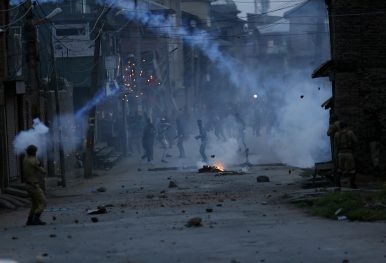By John Braithwaite and Bina D’Costa
 Our new book, Cascades of Violence: War, Crime and Peacebuilding Across South Asia, argues that one of the hidden benefits of preventive diplomacy is that it can reduce various kinds of crime and the self-violence of suicide in one’s own country. Crime and armed conflict are both what we call “cascade phenomena.” With crime, for example, every mass shooting that occurs in the United States markedly increases the probability that there will be future mass shootings. The challenge for every society is to tackle gun culture whenever it has a first mass shooting to prevent the kind of spiral that American school children suffer.
Our new book, Cascades of Violence: War, Crime and Peacebuilding Across South Asia, argues that one of the hidden benefits of preventive diplomacy is that it can reduce various kinds of crime and the self-violence of suicide in one’s own country. Crime and armed conflict are both what we call “cascade phenomena.” With crime, for example, every mass shooting that occurs in the United States markedly increases the probability that there will be future mass shootings. The challenge for every society is to tackle gun culture whenever it has a first mass shooting to prevent the kind of spiral that American school children suffer.
Likewise with ethnic violence. Hindu-Muslim riots in India statistically increase the risks of more violence of this kind, as do Buddhist-Muslim riots in Myanmar and Sri Lanka. Islamist terrorism is a cascade phenomenon as well. It is a phenomenon that feeds on itself, and also feeds on the often heavy handed reactions to it. The way the invasion of Iraq in 2003 strengthened the cascading violence of groups like al-Qaeda and later the Islamic State are cases in point.
The evidence reviewed in our Cascades of Violence book shows clearly that war is a cascade phenomenon. One of the best predictors of whether a country will have a war is whether it has recently suffered one. War cascades across space as well as time. So having a neighboring country that has suffered a war increases the risk that one’s own country will become involved in armed conflict. Our book shows that war cascades to more war, crime to more crime, war cascades to higher crime rates, and crime cascades to war.
Because war and crime are intertwined cascade phenomena, when a country like the United States decides to invade Iraq or Vietnam, it needs to change the way it does its diplomatic calculus. It must also consider what might be the cost of a cascade in Syria to both the people of Syria and the people of the United States, and it needs to factor in the costs of increased homicide (and suicide) in the United States.
Gandhi and early advocates of nonviolence in what is now Pakistan, such as Bacha Khan, had a clear understanding of this propensity for violence to cascade to more violence of variegated kinds. Cascades of Violence is a book that points to evidence that nonviolence can also be a cascade phenomenon. Gandhian traditions of nonviolence have cascaded globally in profoundly important ways from South Asia.
The modern history of Greater India can be read as a formidable cascade of violence and a cascade of domination. Imperial domination cascaded down to a politics of separation of India from the British Empire, which cascaded further down to a violent politics of separation of Pakistan from India, cascading to a war of separation of Bangladesh from Pakistan, which cascaded through many layers of internal conflict within Bangladesh. The South Asian cascade of partitions delivered Muslim and ethnic Bengali homogeneity to Bangladesh without peace. We argue that this was because homogeneity was achieved by a cascade of violence. In the upshot, fundamentalist Islamists continue to inflict terrible violence against more moderate Muslims and vice versa. Tiny ethnic minorities in the Chittagong Hill Tracts launched a civil war after Bangladesh gained independence from Pakistan. After a peace in this armed conflict was settled, different political and ethnic factions took up arms against each other in the Chittagong Hill Tracts.
We find evidence that modern wars can cascade to the creation of Hobbesian rural spaces where sexual violence becomes a strategy, revenge is indulged, rule of law is in abeyance, and insurgents have morphed into gangs of organized criminals. These anomic spaces are in the market for a supplier of order. That supply might come from one organized crime group dominating, from an armed rule of law movement like the Taliban, UN peacekeepers, a state that supplies community policing and a rule of law, or a state military that allows enough pacification to justify its presence and enough anarchy to itself profit from organized crime. The Chittagong Hill Tracts is seen as fitting the last description. Its descent into this condition is viewed through a lens that points from the Chittagong Hill Tracts back through the layers of the above cascades.
Within these cascades from Partition, Kashmir remains the most ugly sore that continues to fester ever new waves of violence. Cascades of Violence argues that the risk that minor exchanges of fire between Indian and Pakistani forces in Kashmir could sooner or later in the long run of history cascade into a catastrophic nuclear exchange. This should make Kashmir one of the region’s and the UN’s top priorities for preventive diplomacy once more.
This article is derived from Cascades of Violence: War, Crime and Peacebuilding Across South Asia from Australian National University Press. It is available for free digital download here.
John Braithwaite leads the Peacebuilding Compared project in the School of Regulation and Global Governance (RegNet), The Australian National University.
Bina D’Costa is an Associate Professor at the Department of International Relations, Coral Bell School of Asia Pacific Affairs, The Australian National University.
No comments:
Post a Comment